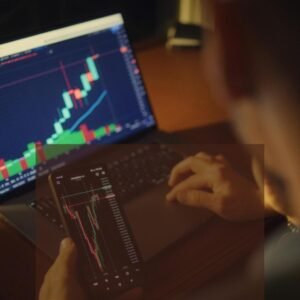Forex Trading: Your Ultimate Marketplace
Introduction to Forex Trading
‘Forex’ or ‘FX’ describes the vast electronic marketplace where international currencies and currency derivatives are traded. This market operates continuously, 24 hours a day, five days a week, making it the world’s largest and most liquid market. It is a global network of buyers and sellers who trade currencies based on market fluctuations and exchange rates. The forex market is highly accessible and offers traders numerous opportunities to buy and sell currencies.

Forex trading is considered one of the most popular and profitable investment forms. However, it requires a deep understanding of market trends, economic indicators, and geopolitical events that impact currency values. Successful forex traders must be able to interpret market data and make informed decisions in real time. They must also manage risk effectively, as the forex market can be volatile and subject to sudden price movements. Despite these challenges, many individuals and institutions engage in forex trading as it offers potentially high returns on investment.
Also read: Balancing Act: Achieving Financial Stability Through Money Management
Table 1.
| Aspect | Explanation |
|---|---|
| Market Structure | The forex market has no central physical location. Most trading occurs through banks, brokers, and financial institutions. |
| Currency Pairs | Currencies are traded in pairs (e.g., USD/CAD, EUR/USD, USD/JPY). Each pair represents the exchange rate between two currencies. |
| Profit/Loss | Traders profit or incur losses based on the difference in the price at which they buy and sell currency pairs. |
| No Cash Transactions | Forex traders do not deal in physical cash; all transactions are electronic. |
Understanding Currency Pairs
In foreign exchange trading, currencies are generally quoted in pairs. These pairs represent the relative value of one currency against another. Each currency pair consists of a base currency and a quote currency. The base currency is the first currency in the pair, while the quote currency is the second. The value of the base currency is permanently fixed at 1 unit, while the value of the quote currency is determined by its exchange rate with the base currency.

For instance, if the EUR/USD pair trades at 1.1500, 1 Euro can be exchanged for 1.1500 US dollars. To buy Euros, you must pay the equivalent amount in US dollars. Conversely, you will receive the equivalent amount in US dollars if you want to sell Euros.
Some commonly traded currency pairs include EUR/USD, USD/JPY, GBP/USD, and USD/CHF. Knowing how to interpret these currency pairs is crucial for anyone looking to trade currencies in the financial markets. It is essential to keep an eye on economic and political developments that can affect the value of currencies. Factors such as interest rates, inflation, and geopolitical events can significantly impact currency prices. By staying informed and understanding how to interpret currency pairs, traders can make informed decisions and potentially profit from currency fluctuations.
Table 2.
| Currency Pair | Explanation | Example |
|---|---|---|
| USD/CAD | U.S. dollar (USD) versus Canadian dollar (CAD). | If the price is 1.2569, it costs 1.2569 CAD to buy one USD. |
| EUR/USD | Euro (EUR) versus U.S. dollar (USD). | A price of 1.3336 means it costs 1.3336 USD to buy one EUR. |
| USD/JPY | U.S. dollar (USD) versus Japanese yen (JPY). | If the price increases to 110.50, it costs 110.50 JPY to buy one USD. |
Forex Lot Sizes

In forex trading, lot sizes determine the volume of trade. Here are the standard lot sizes:
Table 3.
| Lot Size | Units of Currency | Example |
|---|---|---|
| Micro Lot | 1,000 units | Trading $1,000 worth of currency. |
| Mini Lot | 10,000 units | Trading $10,000 worth of currency. |
| Standard Lot | 100,000 units | Trading $100,000 worth of currency. |
Practical Examples
Scenario: An American company orders merchandise from Japan and must pay in yen.
- Solution: The company trades U.S. dollars (USD) for Japanese yen (JPY) to settle the payment.
Speculation: Traders profit from currency value movements.
- Example: Buying EUR/USD at 1.1000 and selling at 1.1200 results in a profit of 200 pips (percentage in points).
Risk Management: Setting stop-loss and take-profit levels.
- Example: Placing a stop-loss order at 1.0950 to limit losses if EUR/USD falls.
Conclusion
The forex trading market is a vast and potentially lucrative space that offers numerous opportunities for financial gain. However, navigating this complex landscape requires a solid understanding of its intricacies, a commitment to ongoing learning, and effective risk management. Whether you’re just starting out or have years of experience, mastering the forex trading market can be the key to achieving your financial goals.



